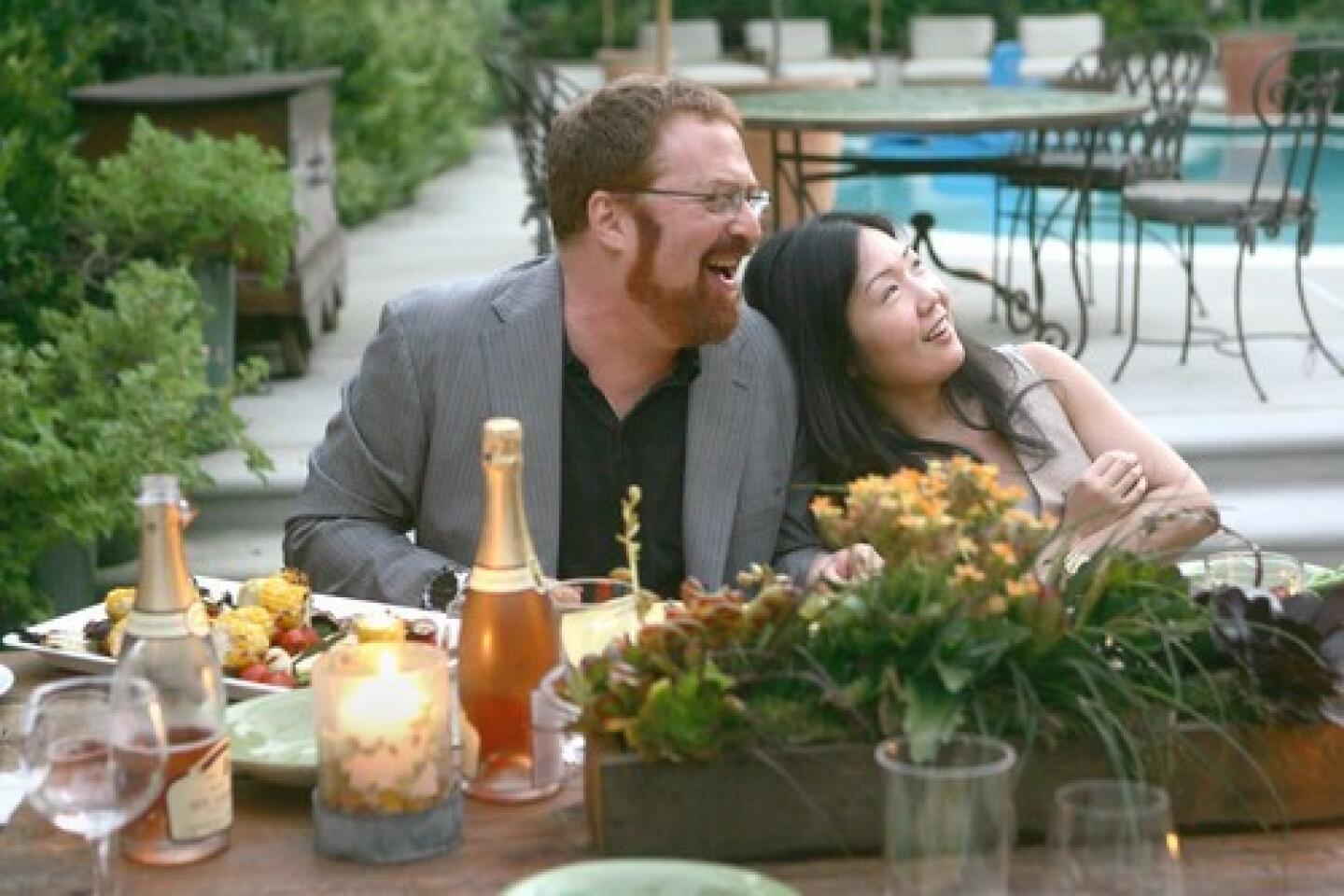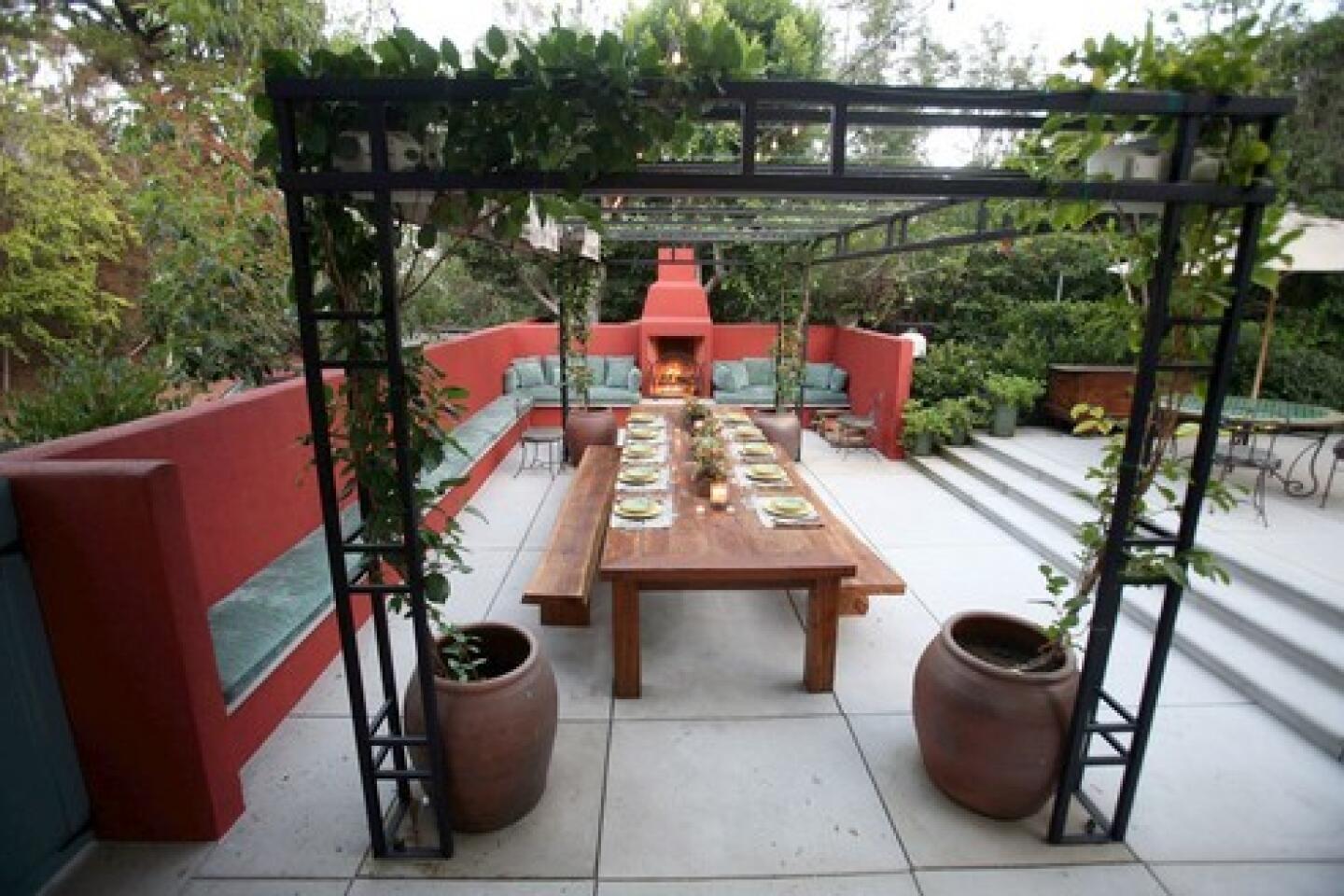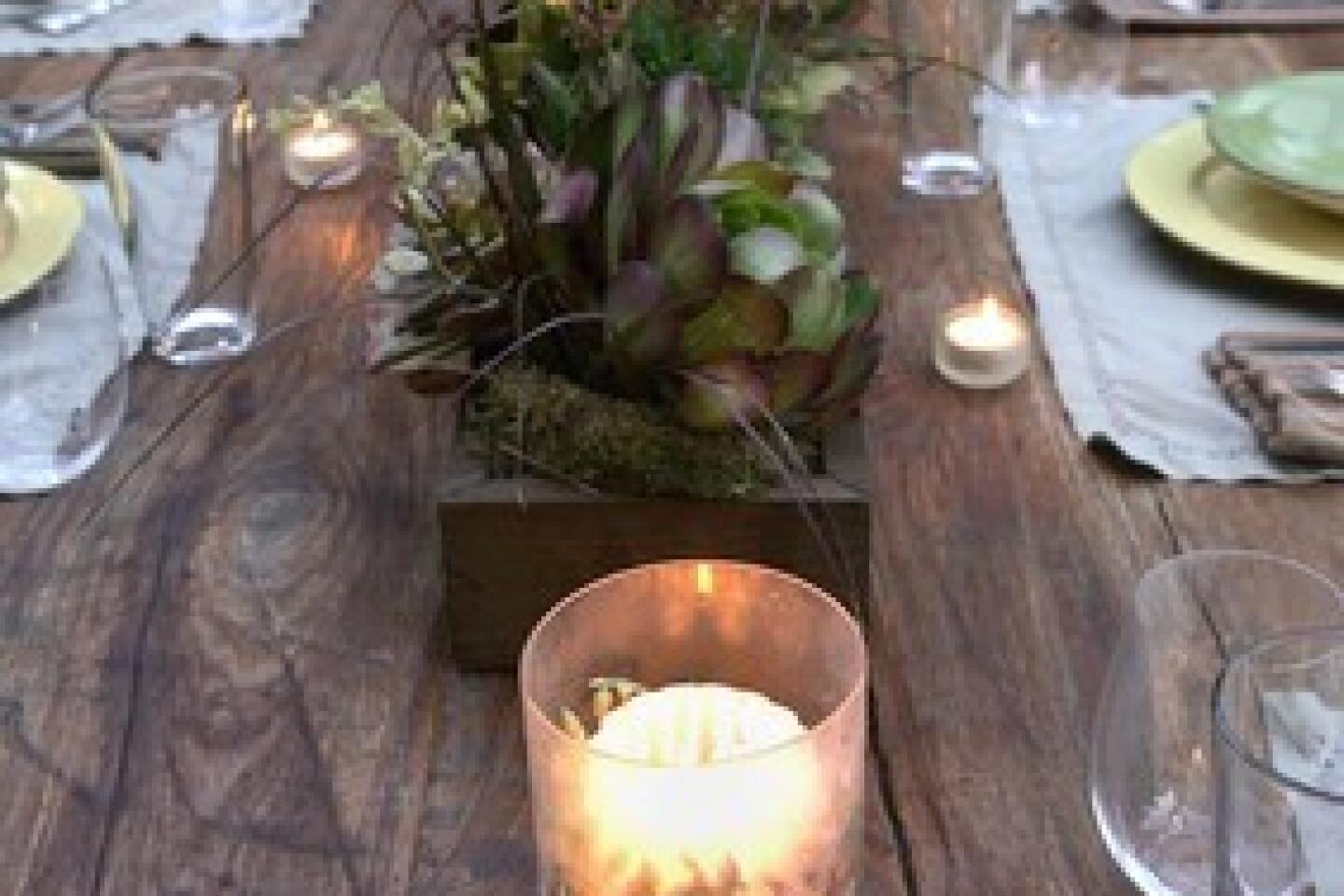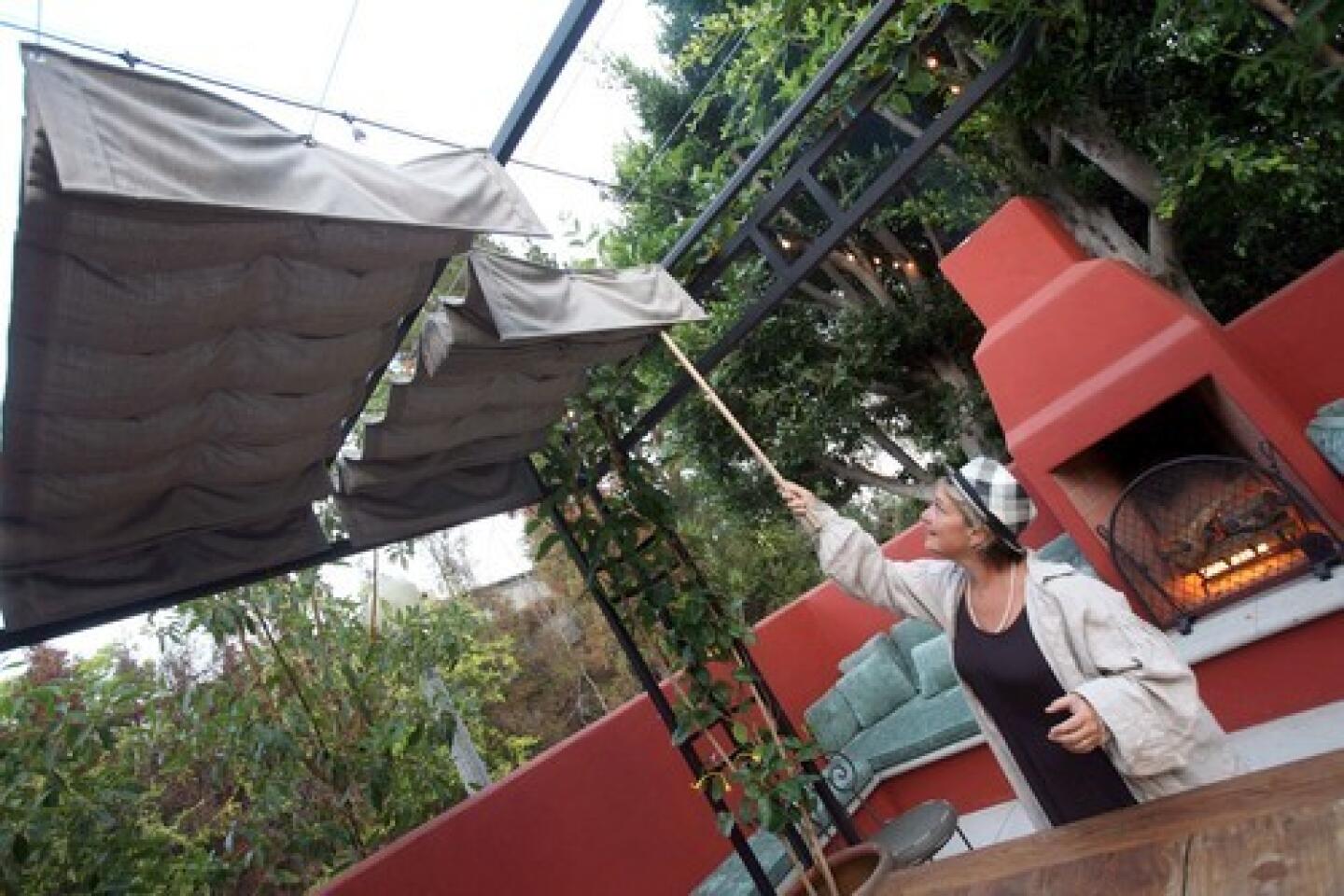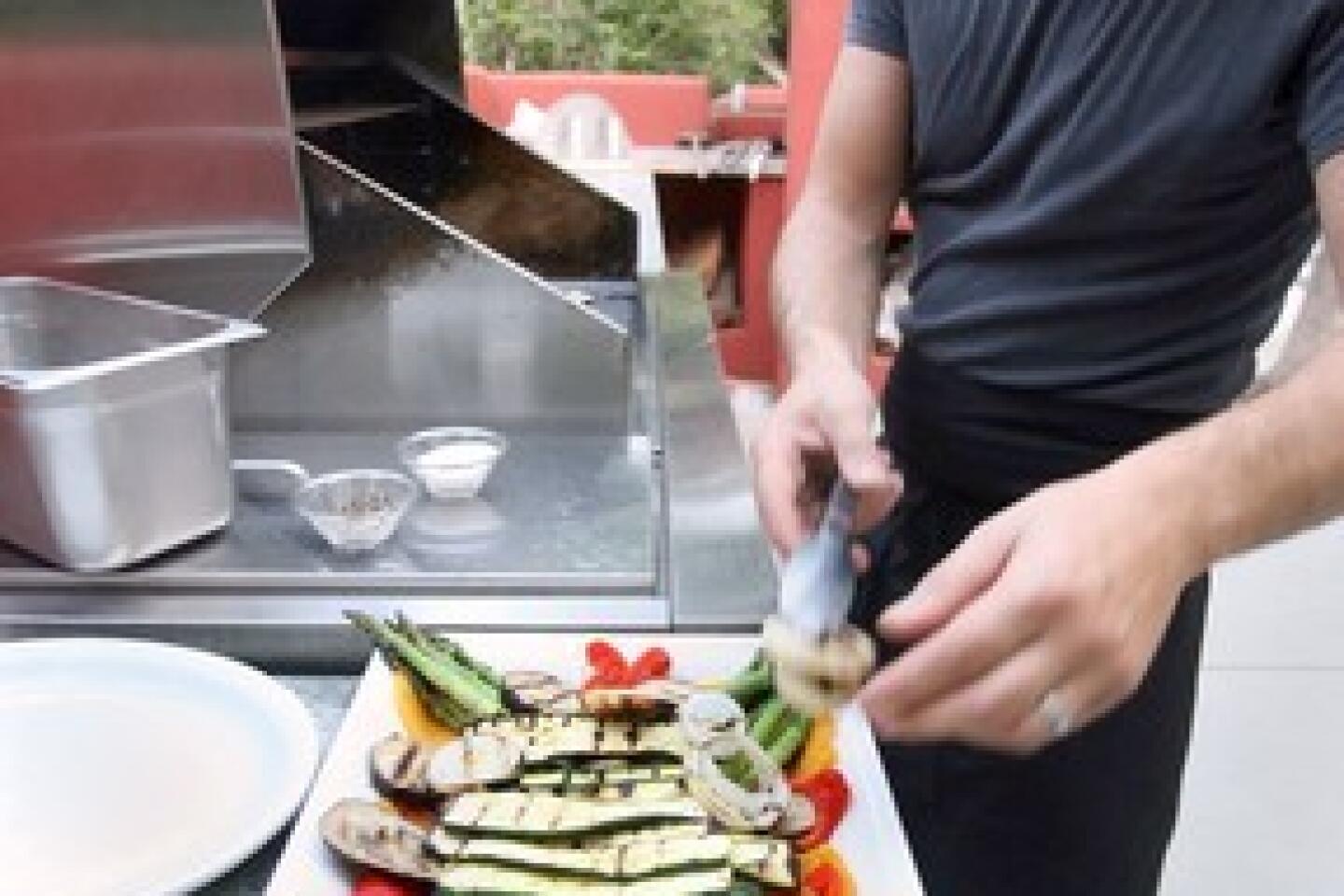R.J. Cutler cooks inside and out
Welcome to the prelaunch celebration for “The September Issue,” director R.J. Cutler’s documentary feature about fashion high priestess Anna Wintour and her creation of Vogue magazine’s most important issue of the year. But unlike the film’s gala preview at the Museum of Modern Art in New York, this is not a red-carpet affair.
Instead, Cutler and his girlfriend, Jane Cha, have gathered a group of friends a few days prior for an intimate, relaxed evening of oven-fired pizzas and savory grilled vegetables, all in Cutler’s new outdoor dining room set under carnival lights and the stars.
Youthful and redheaded, with a trim beard and a mischievous smile, Cutler is the type of guy who prefers to entertain at his Hollywood Hills residence rather than dine out.
“There is a lot of party-giving here,” says the producer-director, whose latest film opens in Los Angeles on Friday. “I’m passionate about cooking, but it wasn’t until I moved into this house that I started focusing on it.”
With flutes of pink Champagne, Cutler welcomes his guests -- Lucinda Cowell and Ron Michaelson, whose design firm Concept Arts created the theatrical posters for “The September Issue,” and MGM lawyer Michael Moore and his friend Karen Thorland, a litigation partner at Loeb & Loeb. Writer and former “Without a Trace” producer Ed Redlich and his wife, Sony Pictures television producer Sarah Timberman, arrive with bottles of Aubert Chardonnay, a pick from their wine cellar that Redlich insists is “the best white wine in California.”
Cutler encourages them all to stroll the garden paths or settle into wicker chairs to watch the pizza-making production. The conversation naturally turns to the host’s soon-to-be-released film, and with some gentle prodding, he shares a few observations of its protagonist, editor Wintour, whom he clearly admires but describes as “sphinx-like, mysterious and apparently impenetrable.”
When Cutler recently remodeled the house’s kitchen, he added a second kitchen outside, complete with wood-fired pizza oven. Today he’s cooking side-by-side with his friend Alberto Lazzarino, who recently closed Melograno in Hollywood to work as a private chef. The men garnish rounds of dough with fresh, simple ingredients and slide them into the oven, which burns at 600 degrees. Minutes later, out come rustic pizzas topped with caramelized sweet onions and homemade sausages; fresh arugula, prosciutto and buffalo mozzarella; and mixed seafood, white sauce and olives. Lazzarino seasons them with fresh herbs clipped from a potted culinary garden nearby.
Cutler says that he imagined “a big conceptual approach” when it came to restoring the 1920s Spanish Colonial Revival home, which he bought in 2005.
To help him pull it off, he enlisted interior designer Lory Johansson, who runs the Los Angeles design studio Just Joh with her architect-husband, Mats Johansson, both guests tonight along with their daughter, Erika.
“The idea was to have a home that resonates with its moment -- the Spanish Revival movement that it owes its architecture to -- and to meld it with more Craftsman touches,” Cutler says.
::
To the self-described “observational filmmaker,” the 4,200-square-foot residence on three-quarters of an acre needed a dramatic narrative, indoors and out. “I saw enormous potential here,” he says. “I loved that the home was huge, but it felt to me as though the spaces could be defined to create intimacy.”
The purchase gave Cutler a lot more house for his money than if he had bought on the Westside, and it moved him closer to the offices of Actual Reality Pictures, his production company on Sunset Boulevard in Hollywood.
At first, the director merely wanted Johansson’s help restoring vintage light fixtures and designing replicas to fit the architecture. The project quickly morphed into six months of cosmetic renovations, including stripping a thick coat of red paint from the wood-and-tile staircase and deep-cleaning the two-story living room’s original ceiling beams.
“It was all about restoration and recapturing a home that was beaten up -- but beautiful underneath,” Cutler says.
The original white-cabinet-and-vinyl-tile kitchen required a major upgrade. Johansson borrowed space from an unused butler’s pantry to extend the kitchen’s footprint, but at 180 square feet, the finished room is still relatively compact. Clever space planning was enough to satisfy Cutler’s culinary needs.
“It was really important to R.J. that the kitchen be the heart of what he was doing here at the house, because he cooks so much,” Johansson says, adding that it’s “definitely a guy’s kitchen.” The espresso-stained white oak flooring, dark cabinets and stainless-steel appliances are decidedly masculine. The main source of color -- green glazed vintage subway tiles -- appears on a backsplash above the stove. Johansson found the tiles at Olde Good Things, an architectural salvage store in downtown L.A. that said they were from a New York City electrical transfer station.
The design addressed Cutler’s space needs with an appliance garage for the food processor, a built-in espresso maker and extra-deep drawers for dishes, pots, mixing bowls and linens. Johansson also tucked a pull-out spice cupboard in a slender opening between the double wall ovens and six-burner cook top.
Cha, an executive producer for “Project Runway,” says she took one look at the spice rack and knew Cutler was the right man for her.
“The spices were organized in this aesthetically pleasing, harmonious yet practical -- dare I say ‘artistic’ -- way,” she says. “It demonstrated to me almost instinctually that this man cares deeply about how elements are put together, how they ‘sing.’ Love at first spice -- I know it sounds crazy, but it’s true.”
::
When Cutler entertains, which happens weekly when he isn’t traveling to shoot or promote his projects, he can be found choosing spices, chopping herbs and tossing ingredients at his kitchen’s trim work island. It’s equipped with a circular vegetable sink, and the counter is topped with a sandy-gold honed marble with veins of mossy green.
Although everyday meals are prepared here, most of his entertaining takes place outside, at the open-air kitchen and dining area.
That’s where Johansson persuaded Cutler to remove an unsightly mudroom not original to the house. Now, just steps away from the back door, the host has a Viking grill, side burner and rotisserie, two under-counter refrigerators and the pizza oven, made by EarthStone of Glendale.
Cutler also gave up an auxiliary parking area to make room for the 20-by-30-foot outdoor dining room.
“It was very convenient to use as a valet space for large parties, but that only happened a half a dozen times a year,” he says. “Now, we use it every day, plus it’s ideal for parties large and small.”
Enclosed by a 6-foot stucco wall and ringed with built-in benches and an outdoor fireplace, the dining area is dominated by a 16-foot-long trestle table made from reclaimed Indonesian teak. Long movable benches flank either side to seat up to 20 guests.
Johansson designed a metal arbor to shelter the table, planting Burmese honeysuckle vines in pots at the base of each column and erecting a custom Roman-shade “ceiling” overhead. The cloth panels slide on cables to screen diners from the afternoon sun or remain open at night, when carnival lights twinkle above.
Though Cutler’s agreement with Wintour called for his complete creative freedom and control over the final cut of “The September Issue,” when it came time to choose paint color for the outdoor kitchen, Cutler yielded to his designer, who insisted on having the final say. Cutler assumed the stucco wall, fireplace and pizza oven would be painted white, like the outside of his house. But late one afternoon, the day before he planned a party to unveil the new kitchen, Johansson convinced Cutler to go with a color that matched the terra cotta roof tiles of his house.
“Lory was right -- and brilliant,” Cutler says. His filmmaker’s observation: Dinner guests look more attractive in the romantic light created by the glow of flames against the reddish-orange walls. “The color is warm and comforting, and it gives the house a bit of a statement as you approach.”
Tonight, Cutler’s observation proves true -- it’s an intimate, inviting scene that no runway or red carpet could match.
